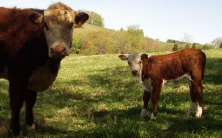Conclusion: Land use taxation benefits the entire community by preserving open space. A landowner that changes use by developing his land only benefits if he has had his property in land use for six or more years. Land use taxation also better aligns tax rates with services provided by the county. Those that are considering ending land use taxation should be wary of the consequences, especially if raw land values are high.
In Virginia, counties have the option of taxing agricultural, forest, and open space based upon “use values” rather than fair market value. Essentially, counties have the option of taxing large tracts of raw land at much lower rates than the tax rate of houses, businesses and other real estate assets.
Lower taxation for raw land in agricultural and forestall use is currently in practice in most of central Virginia, including Fauquier, Culpeper, Orange, Madison, and Albemarle counties. It is much less common for the counties to offer tax breaks for raw land held as “open space.”
Chairman Slutzky in Albemarle County is considering ending the land use program. Some candidates in the Madison County Board of Supervisors race are also talking about ending land use taxation.
I believe the land use taxation program is fair and good for all county citizens. Those involved with local government have enough information to reach similar conclusions, and I’d encourage helping to inform any candidates considering eliminating land use.
The largest source of revenue for counties in central Virginia is the real estate tax. The largest local expenditure is school funding, followed by law enforcement and social services. Education, law enforcement and social services (including CSA’s and CSB’s) account for over 80% of local funding in Culpeper County.
Therefore, over 80% of county expenditures are tied to residents using services. Homes on open land and farms are taxed at the same rate as homes elsewhere. Other large parcels of land under land use taxation are taxed at about 10% of the rate they would be taxed at if not in land use.
When viewed form a stand-point of fairness, meaning services received versus taxes paid, I believe land in land use still provides more revenue than it receives in proportional services.
Some wishing to end land use taxation talk about the means of some of the payers. In other words, some large landowners have lots of money and can afford to pay more. It is true that many large landowners have lots of money, and even those that do not have lots of money usually have lots of wealth. Local government taxation is already progressive in that taxes on homes and businesses are based upon the value of the assets of those homes and businesses. Raw land is taxed at a lower rate, because it does not generate the need for services that houses and their occupants do nor the revenue and need for services that businesses do. Further, raw land is not a liquid commodity. It’s not quick and easy to sell or to borrow against. Finally, raw land benefits others in the community in more ways than by reducing the needs of services. It improves viewscapes, adds visual privacy to surrounding land, increases the value of more densely populated land nearby, and supports agriculture and forests. Finally, large tracts of land offer future development opportunities that could be very beneficial for communities as a whole.
Even if the current system is fair and benefits the community, some argue it is fair to tax all real estate at the same level, regardless of use of county services. They argue that lower taxation of large parcels is a tax break for the wealthy. Currently, many counties have different tax rates for RV’s than they do for cars. Every county that I know of has a different tax rate for cars than real estate. Real estate is not taxed lower in order to give a tax break to land owners – it is taxed lower because officials and citizens electing those officials believe the community as a whole benefits of relatively higher car taxation and lower real estate taxation. Equal tax rates for all property is a policy choice available to local governments, but dramatically higher taxes on raw land could have profound consequences, just as raising the real estate tax to the car tax level would.
Ending land use taxation in areas where raw land values are significantly higher than $1,500-$3,000 per acre will profoundly affect land planning by affected owners. First, owners will be faced with the choice of much higher taxes or of perpetually giving up any future use of their land other than agriculture through conservation easements. A few will choose conservation easements, but I believe most will not. Faced with the choice, I would not choose an easement. Those that choose to not use easements will either have the money to pay the higher taxes or not. Those that don’t will begin trying to sell some of their land. Because of higher costs of owning land with higher taxes, fewer buyers for land will be around. Therefore, land values will decline. The decline will not be all the way back to agricultural values, because there are still uses for land (such as homes and businesses) that will provide more return than farming. Therefore, large farms that are not in conservation easements will decline in number pretty quickly.
Land use taxation is a good thing, and it benefits the entire community by preserving open space. A landowner that changes use by developing his land only benefits if he has had his property in land use for six or more years. Land use taxation better aligns tax rates with services provided by the county. Those that are considering ending land use taxation should be wary of the consequences, especially if raw land values are high.





